
The Studenica Monastery is a 12th-century Serbian Orthodox monastery situated 39 kilometres (24 mi) southwest of Kraljevo and 40.9 kilometres (25.4 mi) east of Ivanjica, in central Serbia. It is one of the largest and richest Serb Orthodox monasteries.
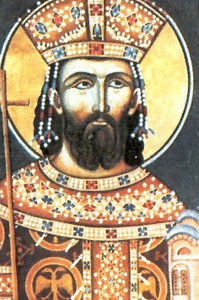
Lazar Hrebeljanović was a medieval Serbian ruler who created the largest and most powerful state on the territory of the disintegrated Serbian Empire. Lazar's state, referred to by historians as Moravian Serbia, comprised the basins of the Great Morava, West Morava, and South Morava rivers. Lazar ruled Moravian Serbia from 1373 until his death in 1389. He sought to resurrect the Serbian Empire and place himself at its helm, claiming to be the direct successor of the Nemanjić dynasty, which went extinct in 1371 after ruling over Serbia for two centuries. Lazar's programme had the full support of the Serbian Orthodox Church, but the Serbian nobility did not recognize him as their supreme ruler. He is often referred to as Tsar Lazar Hrebeljanović ; however, he only held the title of prince.

The Pomoravlje District is one of eight administrative districts of Šumadija and Western Serbia. It expands to the central parts of Serbia. According to the 2011 census results, it has a population of 214,536 inhabitants. The administrative center is the city of Jagodina.

The Sopoćani Monastery, an endowment of King Stefan Uroš I of Serbia, was built from 1259 to 1270, near the source of the Raška River in the region of Ras, the centre of the Serbian medieval state. It is a designated World Heritage Site, added in 1979 with Stari Ras. The monastery is located 15 kilometers (9.3 mi) west of the town of Novi Pazar.
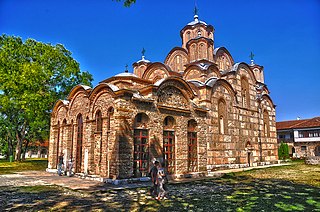
The Gračanica Monastery is a Serbian Orthodox monastery located in Kosovo. It was built by the Serbian king Stefan Milutin in 1321. The monastery was declared a Monument of Culture of Exceptional Importance in 1990, and on 13 July 2006 it was placed on UNESCO's World Heritage List under the name of Medieval Monuments in Kosovo as an extension of the Visoki Dečani site, which was overall placed on the List of World Heritage in Danger.

The Mileševa Monastery is a Serbian Orthodox monastery located near Prijepolje, in southwest Serbia. It was founded by King Stefan Vladislav I, in the years between 1234 and 1236. The church has frescoes by the most skillful artists of that time, including one of the most famous in Serbian culture, the "White Angel", which depicts an angel at Christ's tomb. Mileševa is considered to contain one of the most beautiful works of European arts from Middle ages.

The Manasija Monastery also known as Resava, is a Serbian Orthodox monastery near Despotovac, Serbia founded by Despot Stefan Lazarević between 1406 and 1418. The church is dedicated to the Holy Trinity. It is one of the most significant monuments of medieval Serbian culture and it belongs to the "Morava school". The monastery is surrounded by massive walls and towers. Following its foundation, the monastery became the cultural centre of the Serbian Despotate. Its School of Resava was well known for its manuscripts and translations throughout the 15th and 16th centuries. Manasija complex was declared Monument of Culture of Exceptional Importance in 1979, and it is protected by Republic of Serbia, and the monastery entered the UNESCO Tentative List Process in 2010.

The Ljubostinja Monastery is a Serbian Orthodox monastery near Trstenik, Serbia. Located in the small mountain valley of the Ljubostinja river, the monastery is dedicated to the Holy Virgin.
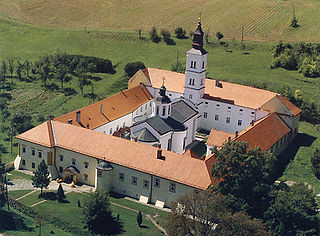
The Krušedol Monastery is a Serbian Orthodox monastery on the Fruška Gora mountain in the Syrmia region, northern Serbia, in the province of Vojvodina. The monastery is the legacy of the last Serbian despot family of Syrmia - Branković. Dedicated to the Annunciation to the Blessed Virgin Mary, it has been described as the "spiritual beacon" of Fruška Gora and "Second Studenica".

Trstenik is a town and municipality located in the Rasina District of central Serbia. As of 2022 census, the town has 13,476, while the municipality has 35,875 inhabitants. It lies on the West Morava river.
Morava architectural school, also known as the Morava style, or simply as the Morava school, is an ecclesiastical architectural style that flourished in the Serbian Late Middle Ages, during the reign of the Lazarević and Branković dynasties.
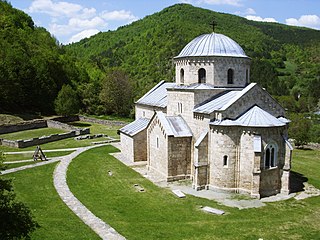
The Gradac Monastery is an endowment of queen Helen which was built from 1277 to 1282 during the reign of her son king Stefan Dragutin. It lies on the elevated plateau above the river Gradačka, at the edge of the forested slopes Golija. Gradac Monastery was declared Monument of Culture of Exceptional Importance in 1979, and it is protected by Serbia.

The Church of St. Achillius or the Arilje Monastery is a Serbian Orthodox church in Arilje, western Serbia. It is dedicated to Saint Achillius of Larissa, a fighter against Arianism and participant of the First Council of Nicaea in 325. The church was built in 1296 by Serbian King Stefan Dragutin of the Nemanjić dynasty and is located in the center of town, on the elevated plateau above the large river valley and the river Moravica and Big Rzav, and represents the most dominant object in the Arilje region.

Church of the Holy First Martyr Stephen, better known as the Lazarica Church, is a Serbian Orthodox church in Kruševac, Serbia. It was built in 1375-1378 as an endowment of prince Lazar of Serbia. Lazarica, as an outstanding achievement of the Serbian medieval architecture, was declared a Monument of Culture of Exceptional Importance in 1979, and it is protected by the Republic of Serbia. Lazarica was built as a prototype of the Morava school of architecture, as a palace church associated with the Kruševac Fortress, the capital of Prince Lazar. Today, only Lazarica and parts of the keep remain from the vast fortress complex.

The Monastery of St. Nicholas is a Serbian Orthodox monastery built by the Grand Prince Stefan Nemanja between 1159 and 1166. It is situated in the center of the historical region of Toplica, near the present day city of Kuršumlija (Serbia), in the upper valley of Toplica river.
Grigorije of Gornjak, also known as Grigorije the Younger and Grigorije the Silent, was Serbian Orthodox monk who was canonized as saint. He studied at Mount Sinai with his teachers were Gregory of Sinai and Romylos of Vidin. Together with a group of Serbian, Bulgarian and Greek monks, Grigorije returned to Moravian Serbia between 1375 and 1379. They established a strong hesychastic colony led by Grigorije. Their patron was Prince Lazar who built the Gornjak monastery for their colony. He endowed it to Grigorije and his fellow monks by written chapter, confirmed by the Serbian patriarch on 17 May 1379. Grigorije spent the rest of his life at the monastery.
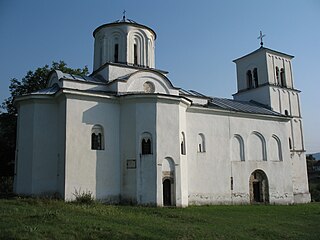
The Nova Pavlica Monastery is a 14th-century Serbian Orthodox monastery located in Pavlica, Raška, in southwestern Serbia. It belongs to the Eparchy of Žiča. The monastery is located near Stara Pavlica, near river Ibar and near old town of Brvenik.

The Monastery of Saint Roman is a monastery of the Serbian Orthodox Church, Eparchy of Niš, in the village of Praskovče. According to some research, the monastery of Saint Roman is considered to be one of the oldest monasteries in the territory of Serbia, established in 1010. It represents an immovable cultural property as a cultural monument of great importance.
Sinaites in Serbia are a special group of clergy, whose name is associated, directly or indirectly, with Mount Sinai, where Moses met God, which established the ties of the Orthodox East with the Serbian lands from the time of Saint Sava, if not before. Traveling to the Holy Mountain, Saint Sava built monasteries and donated funds for their maintenance there for these spiritual ties to continue, especially during the reigns of Prince Lazar, Despot Stefan Lazarević and Djuradj Branković. Serbian monks went to Palestine, but a far larger number of Sinaitic monks also came to Serbia via Mount Athos.

The Drenča or Dušmanica Monastery is located near the place of the same name, not far from Aleksandrovac and belongs to the Eparchy of the Kruševac of Serbian Orthodox Church.































